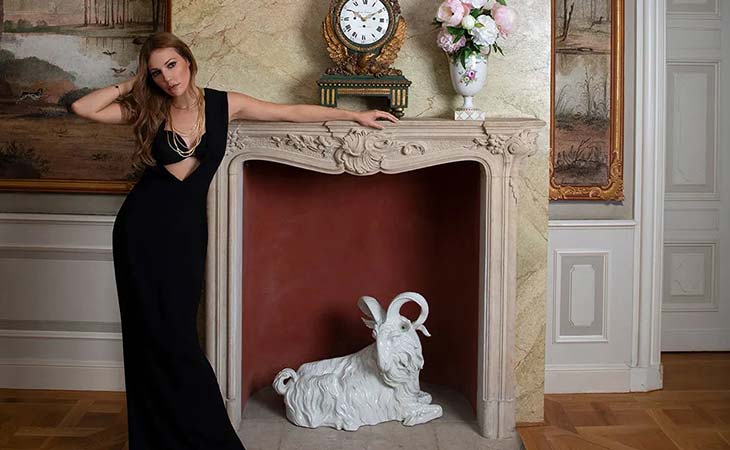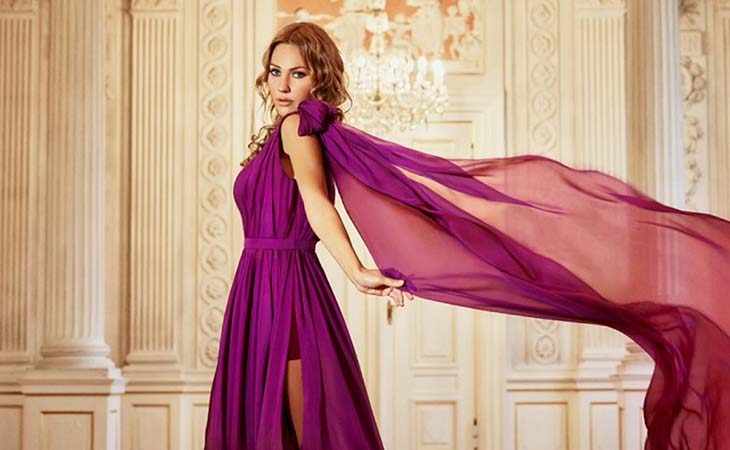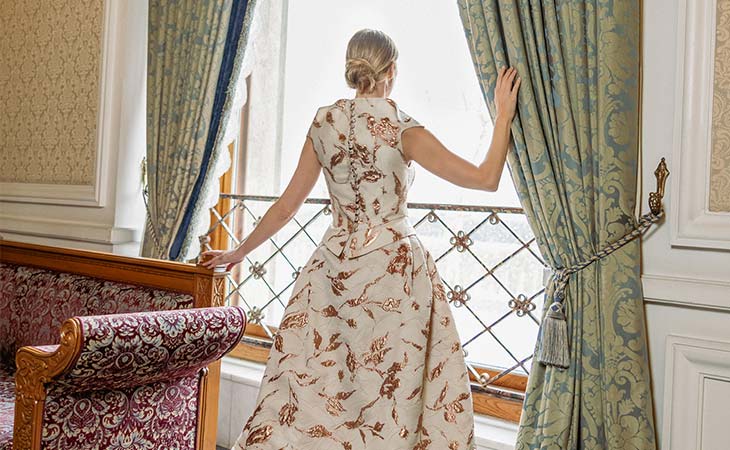Haute couture fabrics are one of the most important pillars of the luxury fashion industry, determining the quality and final value of every garment. According to McKinsey’s 2024 report, the global luxury fashion market exceeds $330 billion, with the haute couture sector growing at an annual rate of around 6%. This remarkable growth reflects the increasing demand for custom, handcrafted, and unique garments made only from the finest and most exclusive materials.
The fabrics and materials used in haute couture, such as Moiré silk, Chantilly lace, and hand-embroidered French guipure, not only create visual beauty and luxury but also ensure the performance and durability of the garments. These luxury materials allow designers to create complex shapes and delicate details that ordinary fabrics cannot achieve.
Using special materials and advanced sewing techniques gives haute couture garments a unique experience for clients—an experience where unmatched quality, comfort, and authenticity can be felt in every stitch and thread. That is why professional and reputable ateliers like “Novague” pay special attention to selecting luxurious fabrics, making it a key criterion in their design and production processes.
Besides beauty and quality, technical aspects such as fabric weight, density, flexibility, and weave type directly affect the durability and performance of haute couture garments. Industry research shows that over 70% of luxury clothing customers prefer products that not only have beautiful designs but also high durability and comfort.
In this article, we will provide a detailed review of various haute couture fabrics, their technical features, and sewing challenges to better understand the importance of these parameters in creating unique and exceptional garments.
Table of Contents
- The Importance of Choosing Materials in Haute Couture
- Moiré Silk: The Masterpiece of Luxury Fabrics
- Chantilly Lace: Elegance in Light Layers
- Hand-Embroidered French Guipure: Art on Fabric
- Technical Features of Haute Couture Fabrics
- Challenges and Sewing Techniques for Special Fabrics
- Why Professional Ateliers Use These Materials
- Conclusion
- FAQ
1.The Importance of Choosing Materials in Haute Couture
Choosing materials in haute couture is extremely important as it forms the foundation for the quality and ultimate success of every luxury garment. Unlike mass-produced clothing, haute couture requires exceptional precision in fabric and material selection to guarantee beauty, comfort, and durability.
The first reason for the importance of material choice is its direct impact on the garment’s appearance and feel. Luxurious and unique fabrics like Moiré silk or hand-embroidered guipure create an exclusive look that ordinary fabrics cannot replicate. These materials reflect light differently and have textures that elevate the sense of touch and visual appeal. In haute couture, every delicate detail such as fabric weight, light reflection, and color scheme is crucial and all depend on the correct choice of materials.
The second point is the impact of materials on the garment’s shape and structure. Haute couture garments often have complex and three-dimensional cuts and silhouettes that can only be executed with special fabrics. For example, structured fabrics like Moiré silk help give volume and architectural forms to the dress without making it heavy or stiff. Choosing the wrong fabric can cause the garment to lose shape or fit poorly on the body, which strongly affects customer satisfaction.
The third reason is the durability and longevity of the garment. Haute couture dresses are a major investment for clients and are expected to last for many years without losing quality. Luxury and high-quality fabrics perform much better against stretching, abrasion, and color fading, and maintaining these features requires precise selection and strict standards in material sourcing.
Furthermore, choosing haute couture materials provides a basis for creating artistic details and special embellishments. Some fabrics allow for intricate embroidery, pearl or crystal installation, and even the use of advanced 3D printing technologies, which would be impossible without suitable materials.
Finally, attention to material quality is a key indicator of professionalism for ateliers and designers. Those who pay special attention to this aspect gain more credibility in the luxury market and maintain loyal and exclusive clients.
Tips for Choosing Suitable Fabrics for Haute Couture Clothing in Winter
2.Moiré Silk: The Masterpiece of Luxury Fabrics
Moiré silk is a type of luxury silk characterized by a wavy, glossy texture that gives a three-dimensional effect to the garment. This fabric is very popular for formal and evening dresses due to its unique appearance and durable structure. Features of Moiré silk include:
- Tight and heavy weave but still soft
- Ability to maintain shape and volumetric form of the garment
- Glossy, wavy surface with attractive light reflection
Comprehensive Women’s Fashion and Style Guide
3.Chantilly Lace: Elegance in Light Layers
Chantilly lace is one of the most delicate and luxurious types of lace used in haute couture for its beauty and compatibility with other fabrics. Its main characteristics are:
- Fine and lightweight weave with floral and intricate patterns
- High breathability and good flexibility
- Requires high precision and skill in sewing due to fabric delicacy
A Comprehensive Guide to Choosing the Perfect Evening Gown: Shine at Every Event!
4.Hand-Embroidered French Guipure: Art on Fabric
French guipure is a thicker, more textured fabric that is hand-embroidered. It is often used to decorate special parts of the garment, creating a luxurious and rich appearance. Its features include:
- Three-dimensional and raised structure
- High durability and resistance to stretching
- Requires special sewing techniques and precise installation
Secrets of Looking Good: Choosing the Right Clothes and Accessories for Every Body Type
5.Technical Features of Haute Couture Fabrics
Every luxury fabric used in haute couture must have specific technical qualities:
- Density and Weight: Heavy enough to maintain the garment’s structure but not so much that it destroys the shape.
- Flexibility: The fabric must be moldable and compatible with precise cuts and stitches.
- Weave Type: Some fabrics like Moiré silk have a wavy weave, others like guipure are raised and three-dimensional, and some like lace are delicate and lightweight.
What Shoes to Wear with an Evening Gown?
6.Challenges and Sewing Techniques for Special Fabrics
Sewing delicate luxury fabrics such as lace and guipure requires high skill and special tools. Common challenges include:
- Preventing tearing and damage to the delicate weave
- Maintaining symmetry and beauty of patterns during cutting and sewing
- Using special threads and needles to avoid holes or uneven stretching
A Journey Through Clothing Styles and Choosing the Right Outfit for Your Personality
7.Why Professional Ateliers Use These Materials
Reputable ateliers like Novague use the finest and most exclusive materials to ensure quality, durability, and the final beauty of their garments. This choice ensures:
- Garments have a unique and unparalleled appearance
- Structure and shape of the dress are precisely maintained
- Comfort and durability are provided for exclusive clients
- Possibility of artistic and customized details is enabled
Check out our store today and pick out your favorite outfit!
8.Conclusion
Haute couture fabrics play an essential and irreplaceable role in creating unique and luxurious handcrafted garments. Selecting special and high-quality fabrics like Moiré silk, Chantilly lace, and hand-embroidered French guipure not only enhances the beauty and visual appeal but also ensures durability, comfort, and precise form structure. These luxury materials combined with advanced sewing techniques enable professional ateliers such as “Novague” to create garments with high standards, unmatched quality, and artistic finesse in a competitive market.
Ultimately, the importance of haute couture materials goes beyond mere aesthetics; these special fabrics and materials form the foundation for conveying art, creativity, and authenticity in every garment. Every successful haute couture design is the result of careful and intelligent selection of these materials, combined with the skills of designers and tailors, giving garments a unique identity. For any atelier aiming to stand out in the luxury fashion arena, paying special attention to the quality and features of materials is the key to success and customer satisfaction.
9.FAQ
- Why aren’t ordinary fabrics used in haute couture?
Ordinary fabrics cannot provide the quality, durability, and special look required for handcrafted luxury garments. - What makes Moiré silk different from regular silk?
Moiré silk has a wavy and glossy texture that gives a three-dimensional effect and more durable structure compared to plain silk. - Is sewing delicate fabrics like lace difficult?
Yes, it requires skill and specialized tools to prevent damage and maintain delicate stitching. - How do these luxury fabrics affect the price of the garment?
Due to their high quality, uniqueness, and complex sewing processes, these fabrics significantly increase the final price of the garment.



